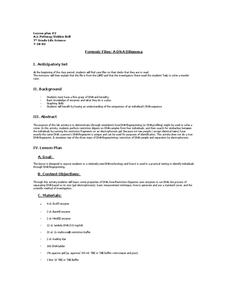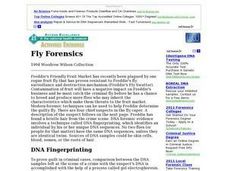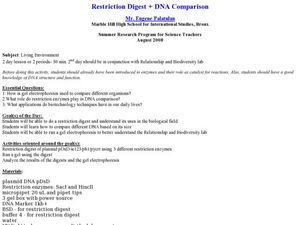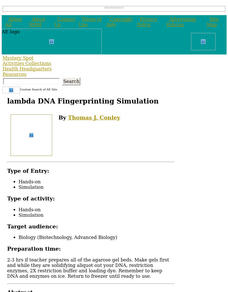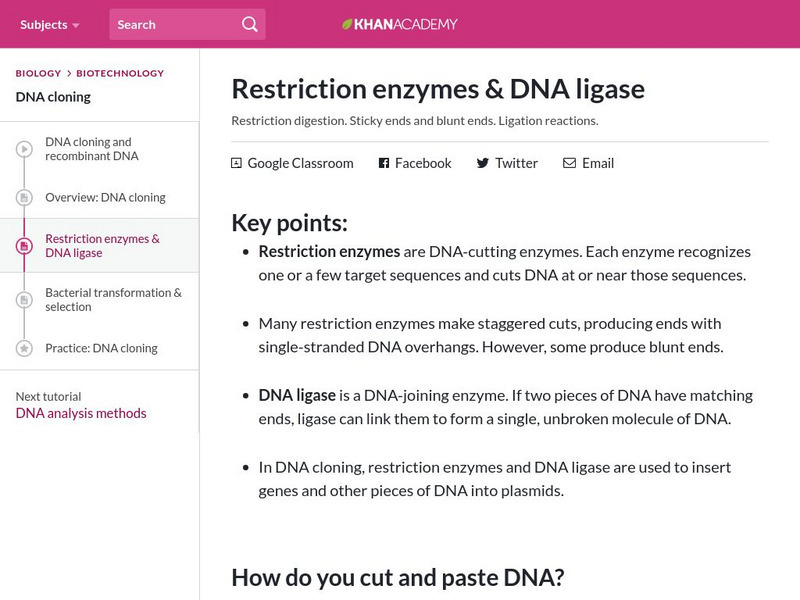Curated OER
Using a Controlled Experiment to Identify Two Unknown Plasmids
Student demonstrate knowledge of recombinant DNA techniques (restriction enzyme digest, gel electrophoresis, and staining gel). They demonstrate skills needed to complete a gel electrophoresis and interpret a stained gel. Pupils solve...
Curated OER
Forensic Files: A DNA Dilemma
Seventh-graders come in to science class to find a file on their desks detailing a crime to be solved! As a demonstration, you simulate the restriction of DNA samples and separate them by electrophoresis. From the gel, learners can...
Curated OER
Gene Cloning Worksheet #1
In this gene cloning worksheet, students are given a gene sequence of DNA, plasmid DNA, 3 restriction enzymes, their cut patterns and a DNA ligase. They answer 6 questions about the results of using different restriction enzymes to cut...
Curated OER
Fly Forensics
Freddy's Friendly Fruit Market is under attack by fruit flies, and it is up to your aspiring biologists to solve the crime! By reading and analyzing the phenotypes, detectives determine which fly is responsible. This memorable assignment...
Curated OER
Restriction Digest + DNA Comparison
Learners compare different DNA and run a gel electrophoresis. In this DNA lesson students complete a DNA activity that allows them to better understand its structure and function.
Curated OER
lambda DNA Fingerprinting Simulation
Students perform restriction digests on DNA samples from four individuals, and then search for similarities between the individuals by running the restriction fragments on an electrophoresis gel.
Curated OER
Determination of Phylogenetic Relationships Using Restriction Analysis
Young scholars applied various mathematical analyses to interpret their data. By using the resulting DNA fragment patterns from several enzymes students established a possible evolutionary relationship among the mice.
Curated OER
The Cloning of Plasmid and Spinach DNA
Students will first extract genomic DNA from spinach and perform a restriction enzyme digestion on both the spinach DNA and the plasmid using the same restriction enzyme. They then ligate the cut plasmid DNA with the cut spinach DNA in...
Curated OER
Cloning of Plasmid and Spinach DNA
Students ligate fragments of genomic DNA from spinach into a vector plasmid. They perform a restriction enzyme digestion. Student use a ligated DNA molecule to transform E. coli cells. Students analyze their procedures and outcome of...
Curated OER
Gel Electrophoresis
High schoolers conduct a variety of experiments to explore gel electrophoresis. For this biology lesson, explain how this process separate DNA and RNA. They discuss the practical applications of this method.
Curated OER
COMPARISON OF FOUR-, SIX-, AND EIGHT-bp CUTS IN CALF THYMUS DNA
Students use this laboratory exercise, restriction enzymes to recognize a four-, six-, and eight-nucleotide sequence. Assuming that the four component nucleotides (A, C, T, G) are distributed randomly within a DNA molecule, then any...
Curated OER
Comparison of Four-, Six-, And Eight-bp Cuts in Calf Thymus Dna
Students investigate the use of restriction enzymes to recognize a four-, six-, and eight-nucleotide sequence. They utilize restrictive endonucleases to cut Thymus DNA and compare results by viewing the DNA fragments on Agarose Gel...
Curated OER
Recombinant DNA - Electrophoresis Demonstration and Problem
Suitable for an AP Biology class, the lab found here has teen bioengineers working with plasmids to clone DNA. If you have not done a similar lab, the instructions may be rather difficult to follow. Both the teacher and learner...
Curated OER
The Great Cafeteria Caper
Students extract DNA from their own hair roots. They run an electrophoresis gel to examine patterns of their DNA along with standard DNA. The experiment is based on a crime scene scenario.
Kenan Fellows
Unit 2: DNA Analysis
Ever wonder how they solve those mysterious murders in TV crime dramas? The second of four units in a Biotechnology series introduces scholars to the many methods of DNA analysis. Pupils create and run their own gel electrophoresis...
Curated OER
Agarose Gel DNA Quantitation
Students examine agarose gels to compare a known DNA sample to an unknown sample to determine the quantity and size of an unknown DNA sample.
Curated OER
Cracking the Code - Cloning Paper Plasmid
Students explore the "genetic code." They observe how genes may be manipulated for genetic research, gene cloning, and genetic engineering. In a lab setting, students examine the mechanics involved in cutting and ligating DNAs into a...
Khan Academy
Khan Academy: Restriction Enzymes & Dna Ligase
Learn about restriction digestion, where the result has sticky ends and blunt ends. Also find out about ligation reactions.
John Wiley & Sons
Interactive Concepts in Biochemistry: Restriction Digestion/gel Electrophoresis
Tutorial explains the processes of restriction digestion and gel electrophoresis and provides an interactive exercise to further your understanding.
ClassFlow
Class Flow: Gel Electrophoresis & Restriction Mapping
[Free Registration/Login Required] Following basic lab techniques of modern molecular biology, analyze the gel electrophoresis results of a restriction enzyme digest of DNA by using a HindIII-generated standard curve. Then solve two...



